Southport Tramways Company
History
The Southport Tramways Company began life operating a standard-gauge, horse drawn system in Southport and Birkdale, its first line opening on the 31st May 1873. It settled down to a moderately profitable existence, which was only disturbed in 1896, when Southport Corporation purchased the tracks within the municipal boundary. The corporation wished to have control of the tramway in the town, but at that time, did not want to run the trams itself, so operation was leased back to the STCo.
At its maximum, the STCo's horse tramway comprised two lines totalling 6.25 miles, one running southwestwards from Churchtown via Roe Lane to Lord Street, turning inland along Aughton Road and York Road to Birkdale Station, the other running northeastwards from Lord Street to Churchtown, but closer to the shore along Cambridge Road.
Although a second horse tramway, which was owned and operated by the Birkdale and Southport Tramways Company (opened in 1883), operated in the town, its tracks were never joined to those of the STCo, despite virtually meeting at London Square on Lord Street.
In 1899, a controlling interest in the STCo was acquired by the British Electric Traction Company, which at this time was aggressively purchasing horse and steam-operated tramways across the British Isles, with the intention of converting them to electric traction. The BETCo also gained control of the Birkdale and Southport Tramways Company, in the hope of creating a single electric tramway system for the town. Although Southport Corporation were initially favourable, they subsequently decided to build and operate their own municipal system, leasing some lines to the STCo and operating the others itself.
In 1901, a new 21-year lease was signed with the corporation, the latter converting the lines within the municipal boundary to electric traction, and the STCo doing likewise for those outside the boundary, i.e., in Birkdale, where the Urban District Council purchased the tracks then leased them back to the STCo. The first STCo-operated electric service ran on the 1st August 1901, with the last horse tram service running in early 1902, probably in March of that year.
The STCo's electric system comprised 8.03 miles of tramway, 5.19 miles leased from Southport Corporation and 2.84 miles from Birkdale UDC. It operated services from Churchtown southwestwards to Southport (inland via Roe Lane ,and nearer the coast along Cambridge Road), along Lord Street, before turning inland along Aughton Road and then southwards to a terminus outside the Crown Hotel in Birkdale; a branch also ran southwestwards from Aughton Road to the Smedley Hydro Hotel in Trafalgar Road, Birkdale.
The tracks in Birkdale passed into the hands of Southport Corporation on the 1st April 1912, when the latter became a County Borough, absorbing Birkdale UDC in the process. The council now owned all the tracks, and on the 1st March 1918, it purchased the assets of the STCo, subsuming the STCo's services into the municipal tramways.
Uniforms
The Southport Tramways Company operated horse tram services from 1873 through to 1902. Photographs of the earliest years of operation appear, however, not to have survived, so it is currently impossible to state whether or not staff were issued with uniforms.
Photographs dating to the early-to-mid 1890s suggest that both conductors and drivers wore informal attire, though precise dating is problematical. By the late 1890s, possibly coinciding with the take-over of the company by the British Electric Traction Company, uniforms were being issued. Conductors wore single-breasted jackets with five buttons and stand-up collars; the latter may have carried insignia of some kind, though this cannot be made out with any degree of certainty on the surviving photographs. Drivers were also issued with uniforms — a somewhat unusual policy for a horse tramway — comprising double-breasted jackets with four pairs of buttons and lapels, the latter appearing to carry some kind of badge, possibly embroidered. Conductors and drivers both wore kepi-style caps with a glossy peak and a small cap badge of unknown pattern, possibly an employee number.
In 1899, the company became a subsidiary of the much larger BETCo, a concern which at its zenith either owned, part-owned or leased around fifty tramway concerns across the British Isles. Photographs clearly show that following electrification, staff were issued with the familiar and largely regulation BETCo uniform. Although jackets appeared to vary somewhat between BETCo systems, as well as across the decades, the cap badges, collar designations and buttons invariably followed a standard pattern.
The precise chronology of the uniforms is currently unclear, though it is possible that the initial issues were double-breasted, with four pairs of buttons, three pockets at waist level, and lapels; the latter probably carried individual letters on both sides — either 'S T C' or 'S T Co’ — almost certainly embroidered, the overall effect being almost naval in appearance. Caps were initially soft-topped with a glossy peak, and carried a standard brass BETCo ‘Magnet & Wheel’ cap badge (see below), worn above an employee number (brass numerals).
At some point in the early Edwardian era, the jackets were changed to a single-breasted design with five buttons and stand-up collars; by analogy with other BETCo systems, the latter probably carried brass system initials on the right-hand side (probably 'S T C' or 'S T Co'), and an employee number on the left-hand side, again in brass. At the same time, the peaked caps were changed to a tensioned-crown-type, with the standard BETCo 'Magnet & Wheel' badge worn above an employee number, though in later years, the employee number was dispensed with, as it was on many BETCo systems.
Staff were also issued with double-breasted greatcoats with high, fold-over collars; it is unclear whether the latter carried any insignia.
Inspectors wore single-breasted jackets with hidden buttons (or more likely a hook and eye affair) and slit pockets (two breast and two waist), all edged in a finer material than the main body of the garment, and with stand-up collars; the latter bore the grade — 'Inspector' — in embroidered script lettering. The standard ‘Magnet & Wheel’ cap badge was worn on the cap, above a hat band, also bearing the grade — 'Inspector' — in embroidered script-lettering but on a hat band.
In common with many tramway systems, women were employed during the Great War (from 1916) to replace men lost to the armed forces, certainly as conductresses. These ladies were issued with tailored single-breasted jackets with four pockets (with button closures), a waist belt (with button fastening), lapels and epaulettes; both the collars and the epaulettes do not appear to have carried any insignia. A long matching skirt was also worn. Headgear took the form of a baggy peaked cap, often referred to as a motor cap; the caps probably bore the standard BETCo 'Magnet & Wheel' cap badge, though this awaits photographic confirmation.
Further reading
For a history of Southport's tramways, see: 'Southport in the Age of the Tram' by John Dean and Cedric Greenwood; Sliver Link Publishing (2008).
Images
Horse tram drivers and conductors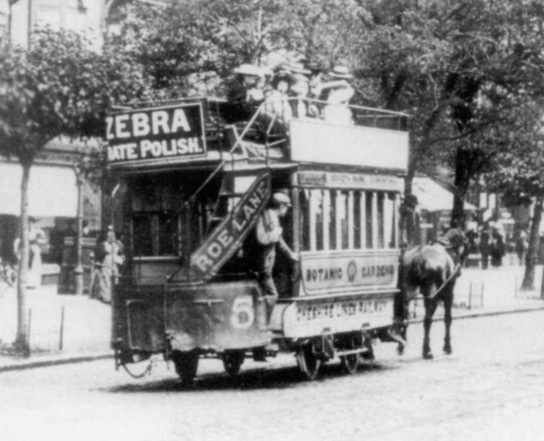
A rather tatty looking Horsecar No 5 makes its way along Lord Street — photo undated, but purportedly taken in 1896. The conductor appears to be wearing informal attire and a flat cap, whilst the driver's bowler hat can just be seen to the right of the far window. Photo courtesy of the Tramways and Light Railway Society.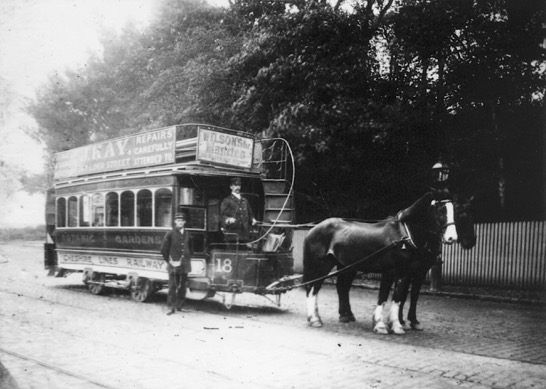
An STCo conductor and driver with awell-turned out Horsecar No 18 at what is probably the terminus outside the gates to the Botanic Gardens — photo undated, but possibly taken in the late 1890s. Photo courtesy of the Tramways and Light Railway Society.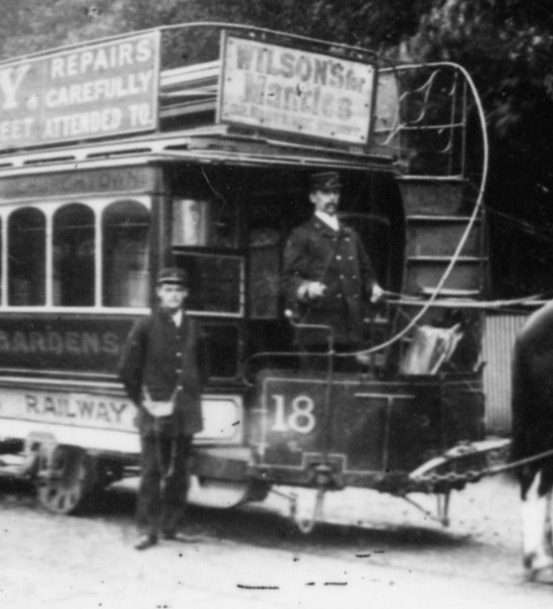
An enlargement of the above photograph showing the crew. The conductor is wearing a single-breasted tunic whilst the driver's is double-breasted; both men are wearing kepi-style caps.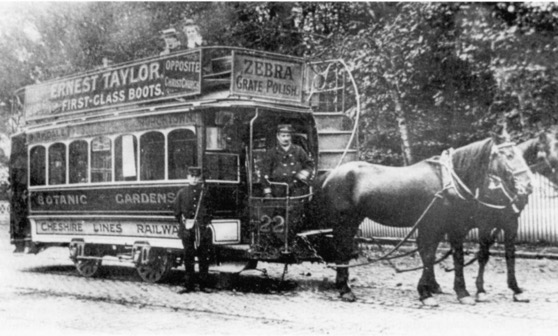
Another photograph taken outside the Botanic Gardens terminus, this time with Horsecar No 22 — photo undated, but probably taken in the late 1890s. Photo courtesy of the Tramways and Light Railway Society.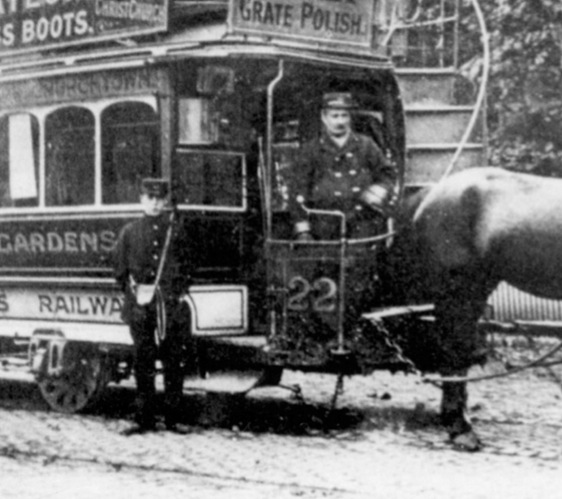
An enlargement of the above photograph. Once again the conductor is wearing a single-breasted jacket and the driver a double-breasted one. Both men are also wearing kepi-style caps with a small badge of some description.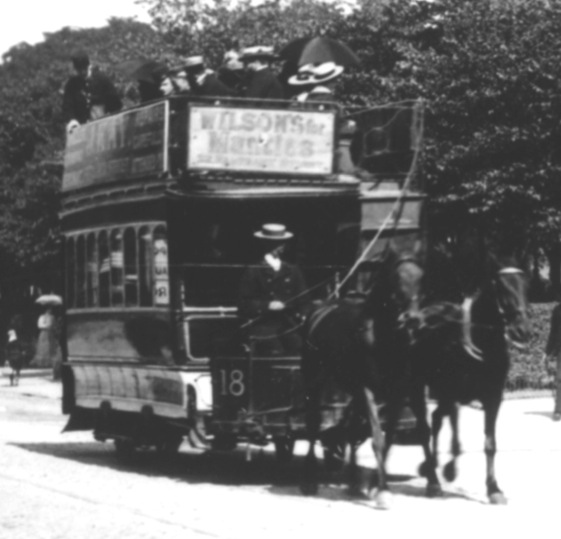
Another shot of Horsecar No 18, this time on Lord Street; photo undated, but probably taken around the turn of the century. The conductor (on the top deck) is wearing a single-breasted jacket and a kepi-style cap, whilst the driver appears to have swapped his kepi for a straw boater. Photo courtesy of the Tramways and Light Railway Society.
Motormen and conductors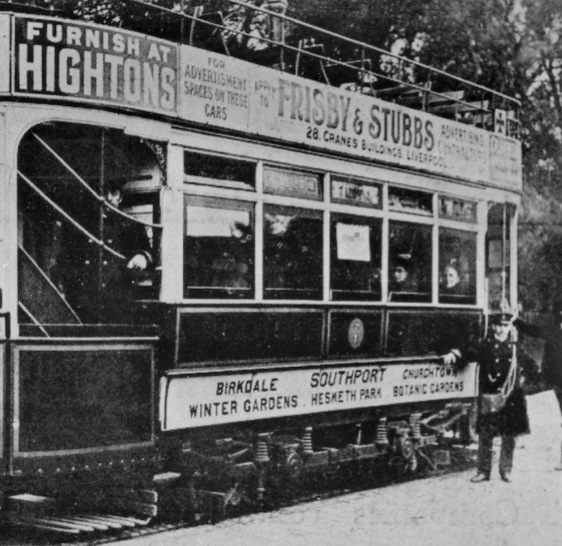
A motorman and a conductor with electric Tramcar No 4; photo undated, but probably taken between 1907 and the start of the Great War. The small cap badges are the standard British Electric Traction Company's 'Magnet & Wheel' variety. Photo courtesy of the Tramways and Light Railway Society.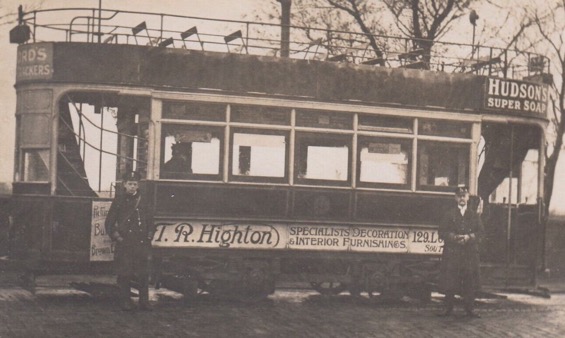
Another rather poor-quality photograph of an STCo tramcar, possibly taken at the Kew Gardens terminus — photo undated, but judging by the condition of the vehicle, and the age of the men (the conductor is quite young and the motorman quite old) possibly taken during the Great War.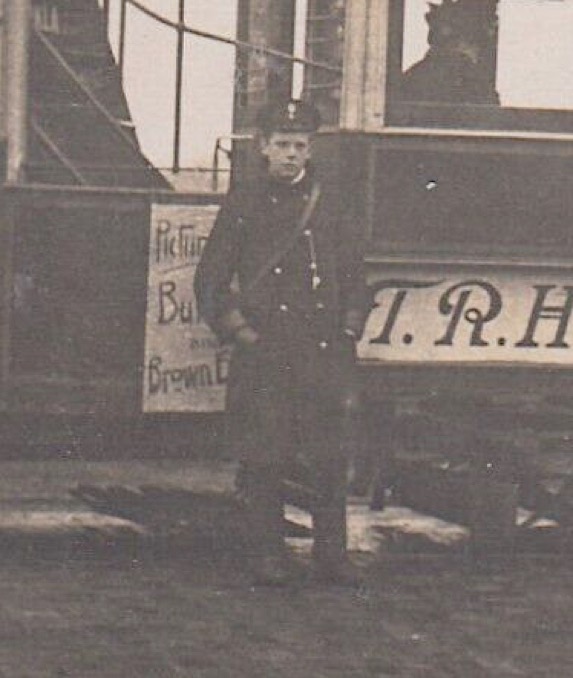
An enlargement of the above photograph showing the conductor in his double-breasted greatcoat and tensioned-crown peaked cap. Although difficult to make out, the cap bears the standard British Electric Traction Company's 'Magnet & Wheel' badge, above a single-digit employee number.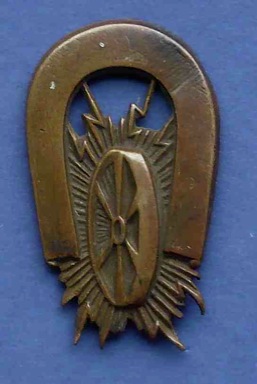
Standard British Electric Traction Company Limited ‘Magnet & Wheel’ cap badge. Author's Collection.